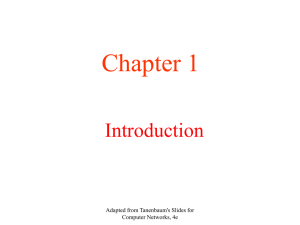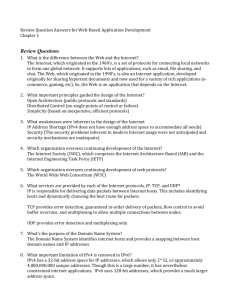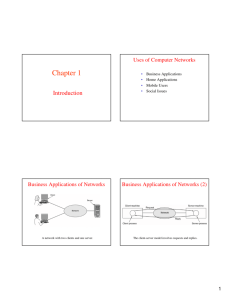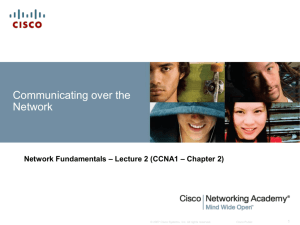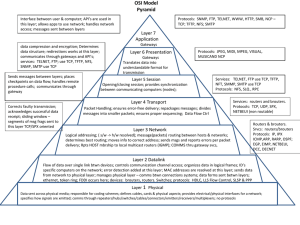Intro to LAN/WAN
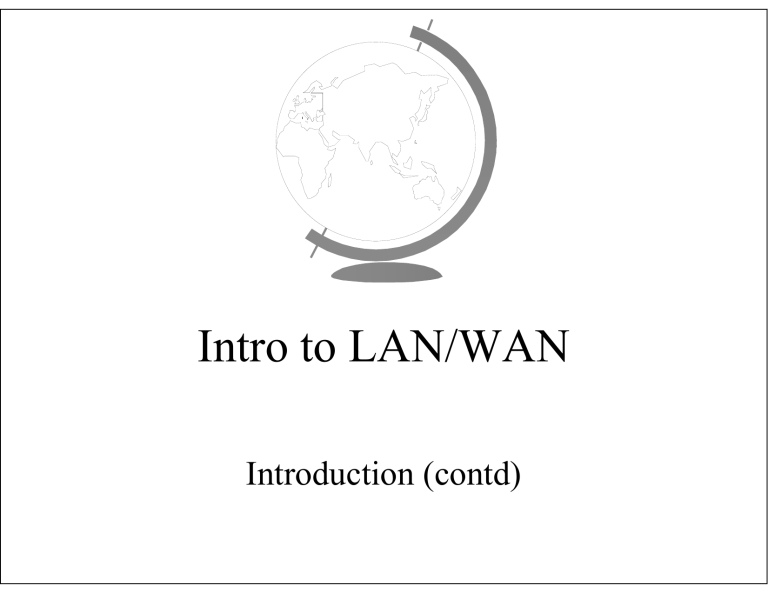
Intro to LAN/WAN
Introduction (contd)
ARPANET
) Military funded, predecessor to the Internet
) Phone lines first, satellite and radio later
– req: connect multiple networks seamlessly
) DoD worry about routers going down
– req: survive loss of subnet hardware without losing connections
) Applications with diverse requirements
– req: flexible architecture
) Used TCP/IP protocols
– then came their reference model
TCP/IP Reference Model
Internet Layer
) Packet switched
) Connectionless
) Packets can be:
– travel different routes
– lost
– out of order
) Called IP ( Internet Protocol )
Transport Layer
) Similar to OSI Transport Layer
– end-to-end, “conversation”
) Two protocols
– TCP: reliable, stream, flow control, connection
– UDP: unreliable, no flow control, connectionless
) Protocols and networks in TCP/IP model initially:
Application Layer
) No session/presentation layers -- no need
) High-level protocols:
– original: telnet, ftp, smtp, dns
– new: http, nntp
Critique of TCP/IP Model
) Not clean in describing service, interface and protocol
– not a good guide for new technologies
) Not general, tied to protocols
– hard to describe other networks
) No physical and data link layers
– hard to abstract from physical hardware
) IP, TCP well-thought out, but others not
– TELNET: 10 cps, no GUI, no mouse
Model Differences: OSI and
TCP/IP
) OSI concepts:
– services: what layer does
– interface: how processes above access it
– protocols: how it works, private to layer
) Not so clean in TCP/IP
– harder to replace as technology changes
Differences: OSI and TCP/IP
) OSI model before protocols
) TCP/IP protocols before model
– model does not fit other protocols
– not useful for non TCP/IP networks
) OSI transport
– connection oriented only
) TCP/IP transport
– connection + connectionless
Hybrid Model
) OSI useful for discussing networks
) TCP/IP provides better protocols for using them
) Hybrid model used in textbook:
Example Networks
) Read 1.5 and 1.6 of text yourself
) Internet
) Asynchronous Transfer Mode (ATM)
) Ethernet
) Wireless LANs
Internet Usage
) Traditional applications (1970 – 1990)
) News
) Remote login
) File transfer
Architecture of the Internet
) Overview of the Internet.
ATM Basics
) Telephone companies coordinate multiple networks
– ex: POTS circuit-switched, other packet-switched
) Invent network of future to manage all
) Transmit data of fixed sized cells
– Flexible (audio, video, text)
– Fast (155 Mbps and 622 Mbps)
) Figure: An ATM cell
) Connection oriented
) Niche, for now, is connecting LAN’s
ATM Virtual Circuits
) A virtual circuit.
Ethernet
) Architecture of the original Ethernet.
Wireless LANs
)
)
(a) Wireless networking with a base station.
(b) Ad hoc networking.
Wireless LANs (2)
) Ad hoc network: Range of a single radio may not cover the entire system.
Wireless LANs (3)
) Infrastructure: A multicell 802.11 network.
IEEE 802 Standards
The 802 working groups. The important ones are marked with *. The ones marked with È are hibernating. The one marked with † gave up.
Outline for Rest of Course
) Intro, reference models, ch 1 (1 day)
) Physical layer, ch 2 (1 day)
) Data link layer, ch 3 (2 days)
) Medium access sublayer, ch 4 (1 day)
) Network layer, ch 5 (2 days)
– midterm exam
) Transport layer, ch 6 (2 days)
– UDP/TCP/IP, ch 6.4 (1 – 1.5 days)
) Upper layers, misc, chap 7
– final exam


